Post-war use of German cruise missiles
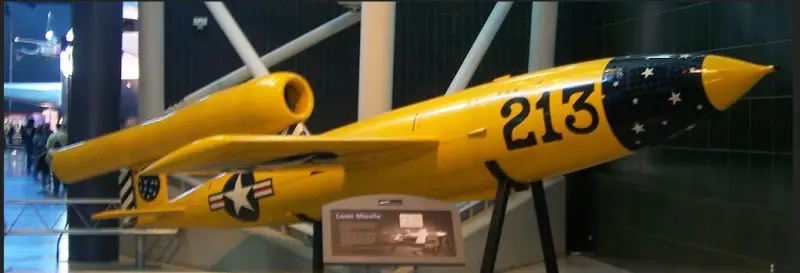
As you know, the leadership of the Third Reich in search of a “miracle” weapons“spent enormous resources on the development of missile technology, and after the surrender of Nazi Germany, the victorious countries received a rich inheritance. Of particular interest were cruise missiles, which were actively used at the final stage of the war and became the object of study and copying in a number of countries.
Creation of the Fieseler Fi 103 projectile aircraft
In the late 1930s, research began in Germany on the creation of unmanned projectile aircraft (flying bombs). According to the German designers, the aircraft, remotely controlled or equipped with an autopilot with a preset program, was supposed to deliver an explosive charge to an enemy target. At the first stage, two options were considered: a disposable projectile aircraft and a returnable unmanned bomber.
During the design work, it became clear that the existing remote control equipment at that time did not provide the required range. In addition, an unmanned aerial vehicle, equipped with a piston engine with a high degree of vulnerability to air defense systems, was comparable in cost to a manned aircraft, which, given the low accuracy of the autopilot with an inertial control system, made the combat use of such an aircraft-projectile unjustified.
The matter moved from a dead point after Argus Motoren brought its pulsating air-breathing engine (PuVRD) to an acceptable level. In 1941, it was tested on the ground by mounting the engine on a car, and then in flight on a Gotha 145 biplane. The engine was given the designation Argus AS 014. Cheap low-octane gasoline served as fuel for the PURD.
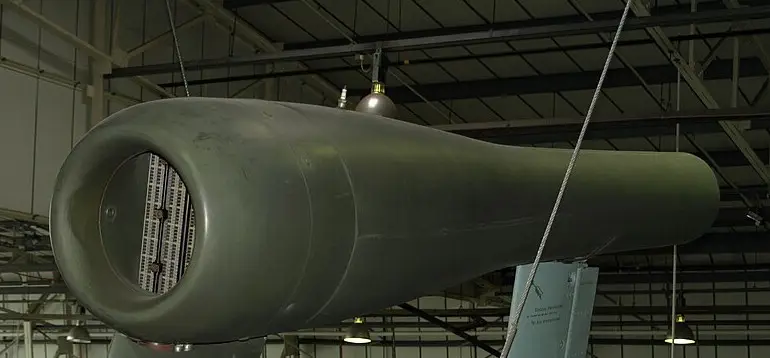
Argus As 014 Pulse Air Jet Engine
The Argus As 014 rocket engine was a cylindrical combustion chamber with a long cylindrical nozzle of smaller diameter. The front part of the chamber is connected to the inlet diffuser, through which air entered the chamber. Between the diffuser and the combustion chamber there is a plate air valve that operates under the influence of the pressure difference in the chamber and at the outlet of the diffuser: when the pressure in the diffuser exceeds the pressure in the chamber, the valve opens and allows air into the chamber. When the pressure ratio was reversed, the diffuser closed. Hot gases flowed through the open end of the pipe, creating jet thrust. The cycle repetition rate in the marching mode of operation was 47 times per second. For the primary ignition of the air-fuel mixture, the chamber had a spark plug, which produced a high-frequency series of electrical discharges.
Thanks to the presence of valves on the Argus As 014 grille, unlike a ramjet engine, constant high air pressure at the entrance to the pipe, blocking it from the “reverse exhaust”, was no longer required. It was enough just to start the engine - and the operating cycle was maintained by itself, using highly heated parts and residual hot gases to ignite the next portion of the air-fuel mixture.
By the standards of piston engines that existed at that time, the Argus As 014 engine, which developed thrust up to 300 kgf, was very voracious. Its wastefulness was clearly evidenced by the extensive torch “shooting” from the nozzle of the PuVRD - a consequence of incomplete combustion of the fuel in the chamber.
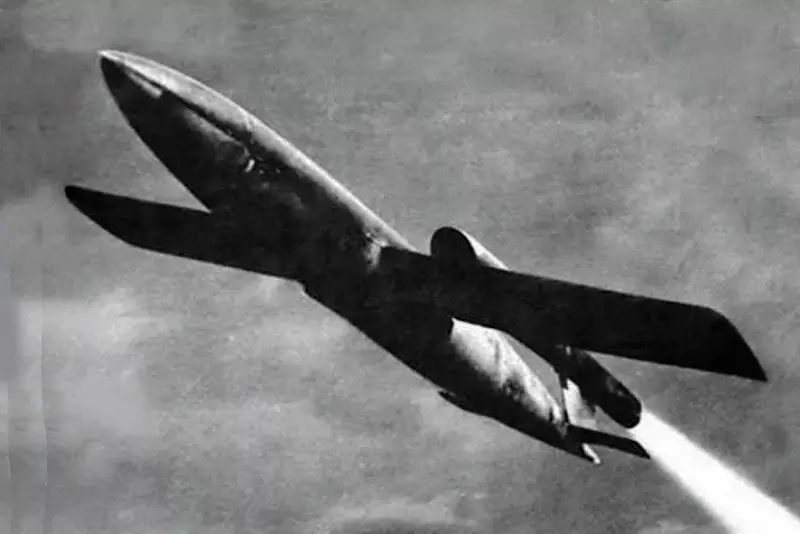
At the same time, the main advantage of the Argus As 014 over piston, turbojet and liquid jet engines was its very low cost and simplicity of design.
The creation of a projectile aircraft (in modern terminology - a cruise missile) was undertaken by the company Fieseler Flugzeugbau. The preliminary design, designated P-35, was ready in April 1942. After reviewing it, the Luftwaffe leadership included it in its Vulkan missile program and allocated funding, assigning the code designation Kirschkern - “Cherry Pit”. However, this aircraft is better known as Fi 103, and also Vergeltungswaffe-1(V-1) - “Weapon of Vengeance”. In Russian-language sources the name V-1 is often found.
Also involved in the project was Askania, which was responsible for the control system. To build a ground-based launcher, the company Rheinmetall-Borsig, which had extensive experience in designing artillery carriages, was hired.
The Fi 103 cruise missile, which had the simplest and cheapest design, was an aircraft with a mid-wing and a single-fin tail. The engine, about 3,2 meters long, was located above the fuselage and tail. Most of the airframe parts were made by stamping from a thin steel sheet, which made the production process cheaper and faster.
Fuel was supplied to the injectors by compressed air from spherical cylinders, which created excess pressure in the fuel tank, which displaced gasoline through a copper tube. There was enough fuel for 22 minutes of operation. Average fuel consumption was 2,35 l/km. Fuel tank capacity – up to 640 l.
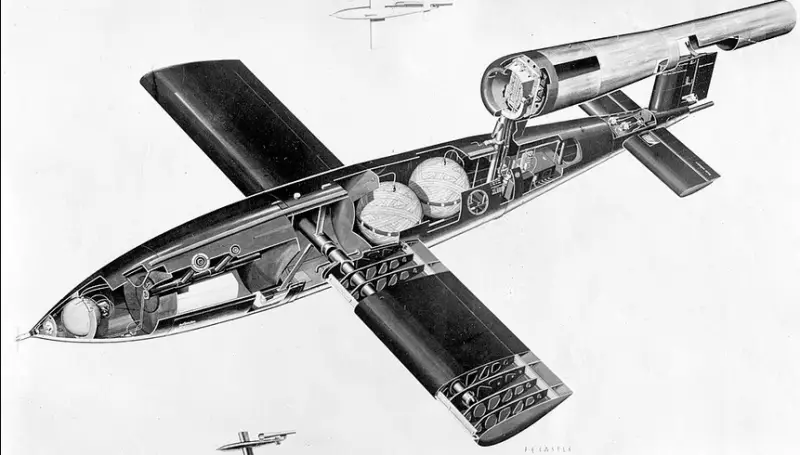
A fairly simple control system was based on a magnetic compass, which controlled the course, and gyroscopes used to stabilize the rocket in roll and pitch. The flight altitude was determined by a barometric altimeter. The distance traveled was recorded by an odometer, which was rotated by a two-bladed impeller installed in the forward part of the fuselage. After 100 kilometers of the journey, the fuse was cocked, and after overcoming the given route, the odometer set the rocket's rudders to a dive and turned off the engine. In the event of a control system failure, the warhead was detonated by a clock mechanism two hours after launch.
The Fi 103 projectile had a length of 7,73 m. The wingspan was 5,3-5,7 m. The fuselage diameter was 0,85 m. The launch weight was 2180-2250 kg. The weight of the warhead was 700-850 kg. Typically, a high-explosive warhead was equipped with cheap ammotol (a mixture of TNT and ammonium nitrate). At the first stage of the flight, the speed was approximately 500 km/h. However, as fuel was used up and weight was reduced, it could reach 640 km/h. A number of sources say that the maximum speed of the Fi 103 reached 800 km/h. But, apparently, we are talking about the speed developed during a dive. The cruise missile could rise to a height of more than 2500 m. But, as a rule, the flight to the target was carried out in the altitude range of 800-1100 m. The flight range was more than 220 km.
The launch was carried out from a ground launcher or from a carrier aircraft. On a ground-based launcher, the rocket was mounted on a trolley, which accelerated to 400 km/h using a piston pushed by steam generated by the combination of concentrated hydrogen peroxide and potassium permanganate. Having taken off from the ground, the rocket separated from the cart and flew towards the target.
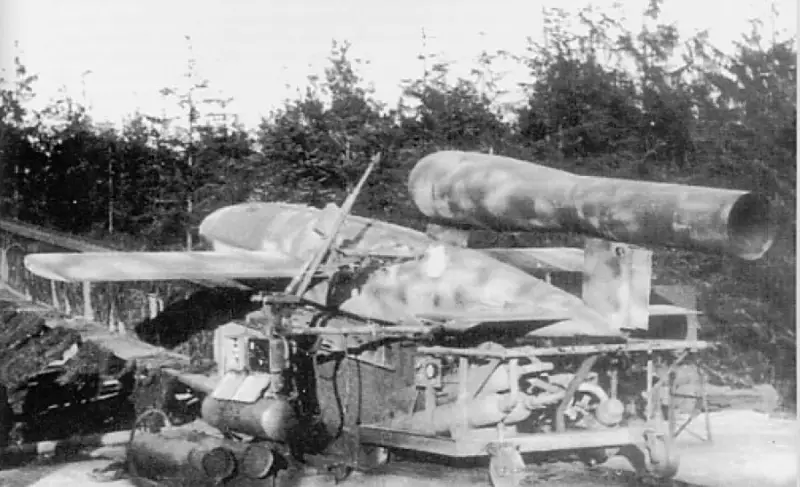
Fi 103 missile aircraft on a launcher
On December 24, 1942, the first launch took place from a ground installation, with the engine turned on. The launched rocket reached a speed of 500 km/h and, after flying about 8 km, fell into the sea.
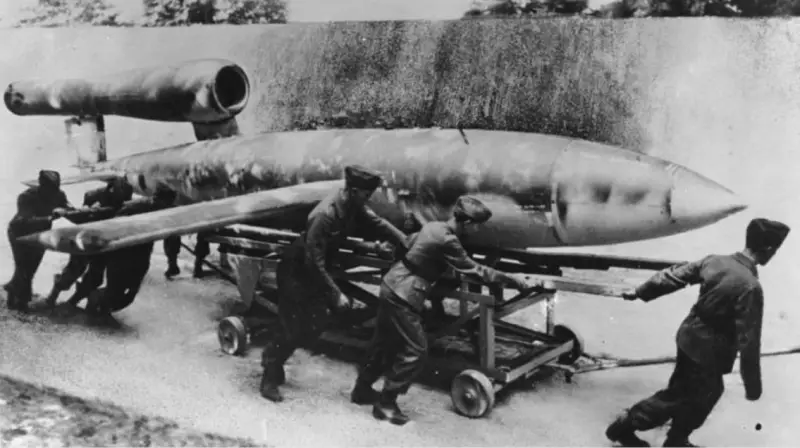
In the summer of 1943, tests of the Fi 103 with a standard control system took place. It turned out that when firing at the maximum range and normal operation of all systems, the missile with a probability of 0,9 fell into a circle with a diameter of 10 km. This circular probable deviation made it possible to use the new weapon only against large area objects, which predetermined the choice of targets.
Production and combat use of Fieseler Fi 103
Serial production of the Fi 103 began in August 1943. Assembly was carried out at four factories: Nordhausen, Ham, South Fallersleben and Magdeburg-Schönebeck. Another 50 companies were involved in the production of components. Until March 1945, more than 25 cruise missiles were built.
200 launchers were deployed in northwestern France, 64 km from London. However, due to technical and organizational difficulties, the first 10 combat Fi 103s were launched on June 13, 1944. Five missiles fell immediately after launch, four failed en route to their target, and only one missile reached London. When it fell in the Toore Hamlets area, 6 people were killed and 9 were injured. In the first weeks, up to 40 missile launches were carried out daily; by the end of August, the number of missile attacks per day reached hundreds.
Some missiles were equipped with radio beacons, and their position was tracked by German direction finders, which made it possible to accurately determine the location of their fall and, based on the data obtained, make adjustments during subsequent launches.
Massive indiscriminate cruise missile fire in the first stage caused panic among the civilian population in major cities. In addition to London, Fi 103 attacked Portsmouth, Southampton, Manchester and a number of other British cities. According to available data, 2419 rockets reached London, killing 6184 people and injuring 17 and destroying or damaging some 981 buildings.
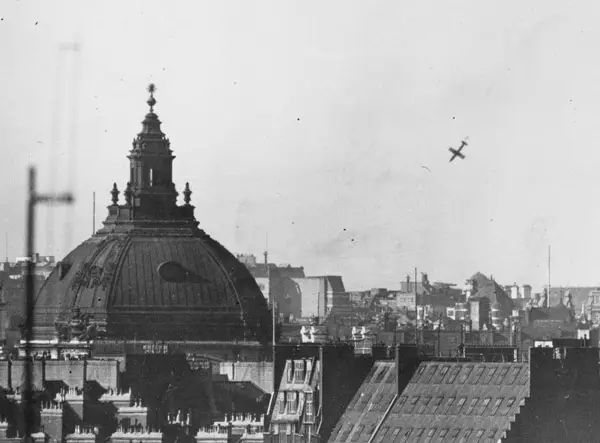
Fi 103 dives into central London, summer 1944
Missile attacks on Great Britain continued until March 29, 1945. The Germans also launched Fi 103 at targets in Belgium and France after the liberation of these territories by the Allies.
Since by the beginning of 1945, Allied troops occupied the French coast, making it impossible to launch cruise missiles from ground-based installations, the Luftwaffe command implemented an alternative plan and launched the Fi 103 from He 111 bombers.
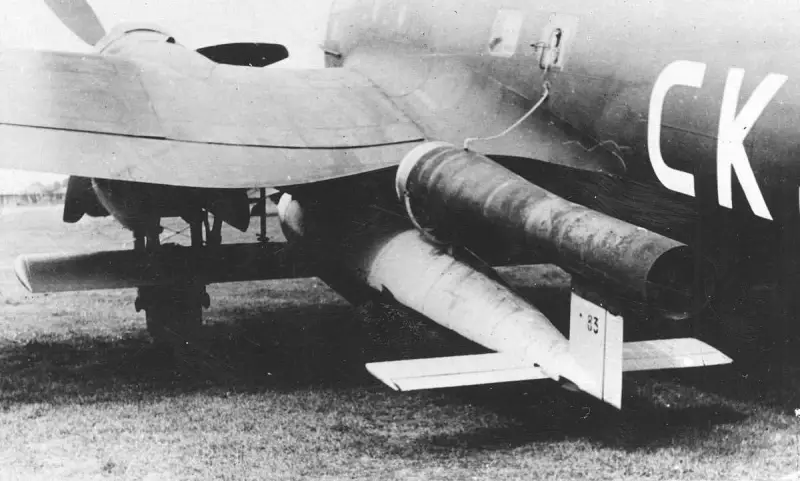
Fi 103 cruise missile suspended under the wing of a He 111 aircraft
Aviation the “flying bomb” version had an increased firing range, achieved through the use of a lightweight warhead and a more capacious fuel tank. When dropped from a bomber, the Fi 103 cruise missile could travel more than 300 km.
A number of sources claim that the “long-range” Fi 103 was also launched from a ground launch position in the Netherlands. In total, about 300 missiles with an increased flight range were launched from the ground and air. Most of them were intercepted by British air defense forces.
To more effectively combat Fi 103, the British command deployed 1500 large-caliber anti-aircraft guns and 700 searchlight installations on the English Channel coast. The radar network has also been improved. “Flying bombs” that broke through this line fell into the range of fighter aircraft. A third line of defense was created in the immediate vicinity of the city - an air barrier of 2000 balloons. A post-war British report states that 7547 "flying bombs" entered English airspace. Of these, 1847 were shot down by fighters, 1866 were destroyed by anti-aircraft artillery, 232 were victims of barrage balloons, and 12 were shot down by anti-aircraft artillery from Royal Navy ships. fleet.
As is known from stories wars, bombing of residential areas and civilian infrastructure most often do not contribute to success on the line of combat contact. In the case of the Fi 103 and the ballistic Aggregat-4 (A-4 or V-2), which will be discussed in the next publication, the Nazis even achieved the opposite effect. The shelling of cities with cruise and ballistic missiles, after the initial shock had passed, contributed to the unity of the British nation and further motivated the soldiers to defeat the aggressor.
Fieseler Fi 103R Reichenberg manned cruise missile
When talking about the Fi 103 cruise missile, it is worth mentioning the manned version, which was not used in combat. The appearance of this modification, known as the Fi 103R Reichenberg, is associated with the inability of the basic “projectile aircraft” to hit point targets.
It was initially planned that the pilot would leave the cockpit with a parachute after hovering the Fi 103R, but it was later decided that the manned “aerial torpedo” should be controlled until it hit the target.
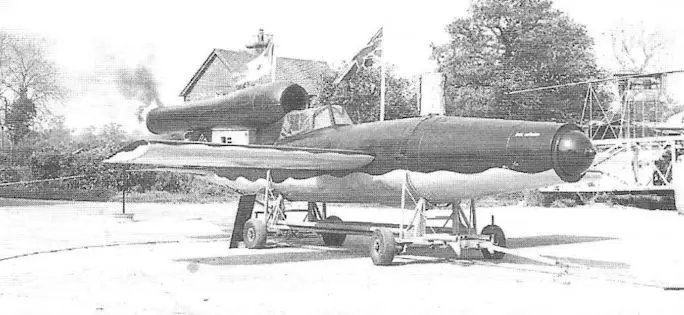
Fi 103R
The cruise missile was converted into a manned version by installing a pilot's cabin in the place where compressed air cylinders were located in the standard Fi 103. To maintain pressure in the fuel system, one cylinder was used, installed at the rear, in place of the autopilot. The fuselage was lengthened by 25 cm to create the necessary legroom for the pilot. During the alteration, the area of the tail surface was also increased, and the controls were connected to the movable steering surfaces by cables. The elevators were supplemented with balancers. Ailerons of increased area appeared on the wings.
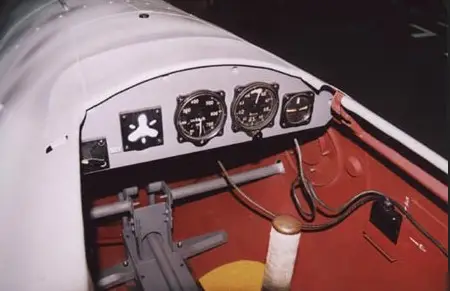
The cockpit was equipped with a minimal set of instruments and a plywood seat. The two-seat training variant featured a retractable landing ski similar to that used on the Me 163. Approximately 175 single and two-seat Fi 103Rs were built. Most of the manned “projectile aircraft” were manufactured in aircraft repair shops.
During the training of suicide pilots, many accidents and disasters occurred. This was due to the fact that the Fi 103 was not originally designed for repeated takeoffs and landings, and the design had a low safety margin. As a result, the program was considered unpromising, and it was closed in March 1945.
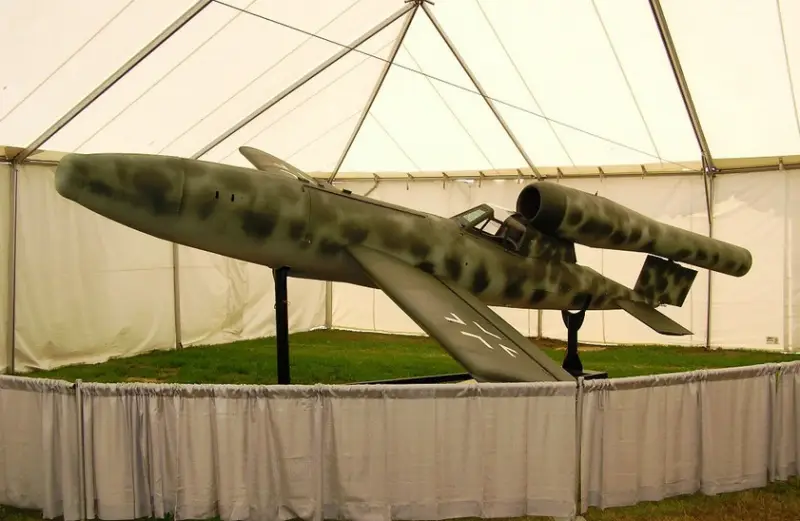
After the surrender of Germany, several Fi 103Rs were at the disposal of the Allies. Now two such aircraft are on museum display.
Post-war cruise missiles based on the Fi 103
In the USA, an attempt to copy the Fi 103 was made in 1944. To do this, the Americans asked the British for details of the crashed “flying bombs”. The development was entrusted to Republic Aviation Corp., whose specialists built a fairly successful copy that surpassed the original in a number of parameters.
The first American cruise missile had several names. In the Air Force it was listed as LTV-1, LTV-A-1 and LTV-N-2, in the Navy - KUW-1. This missile went down in history under the factory designation Republic JB-2 Loon.
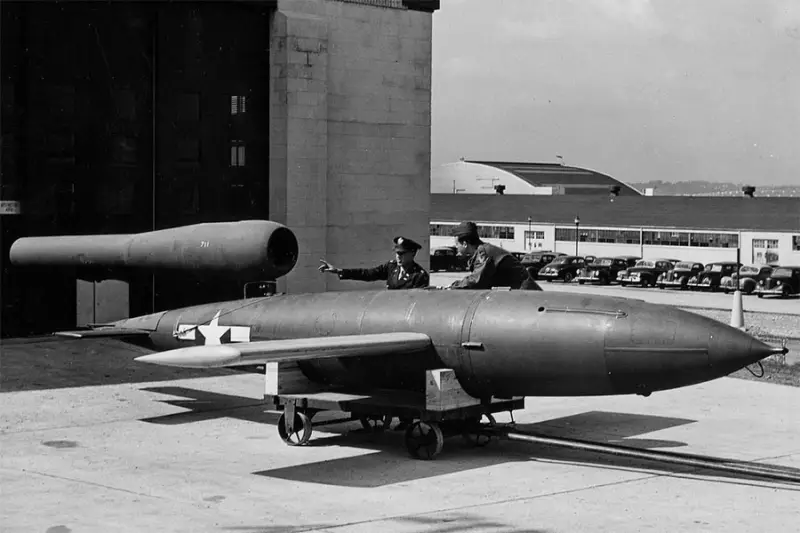
The American Moon rocket was a little longer and had a larger wing area. One of the few visible differences between the JB-2 and the Fi 103 was the shape of the pulsejet engine's forward support pylon. The guidance and flight control systems were manufactured by the Jack and Heintz Company, Monsanto developed the launch system, and Northrop supplied the launch skid. The PJ31 pulsejet engine, built by the Ford Motor Company, had slightly more thrust than the original Argus As 014. Due to the parent company being overwhelmed with orders for P-47 Thunderbolts, the JB-2 airframes were produced handed over to a subcontractor - Willys-Overland. After the start of mass production, experts noted that the JB-2 missiles had much higher workmanship and weight perfection than the Fi 103.
A fully equipped JB-2 missile, equipped with a 910-kg warhead, weighed 2277,5 kg. The flight speed was 565-680 km/h. Firing range – 240 km.
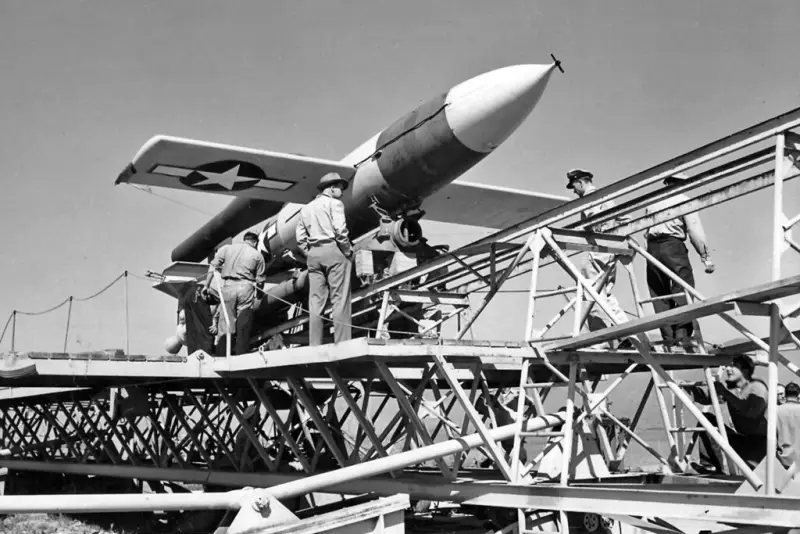
Testing of the JB-2 began in October 1944 at the C-64 site, located in Florida, 35 km east of Eglin Airfield. During the first test launches, it turned out that copying a German cruise missile turned out to be easier than creating a launch complex for it that would ensure stable launches. Before a satisfactory result was achieved, nine launchers of various designs and lengths were tested.
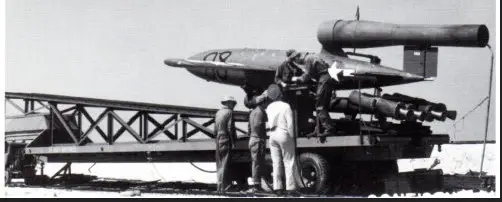
Unlike the Germans, who used a catapult for launch, powered by superheated gas formed during the decomposition of hydrogen peroxide, the Americans used a much simpler and safer to use solid propellant rocket booster, which ensured acceleration of the rocket.
A total of 64 launches were made from the S-233 site. Tests were also conducted at a test site in Utah, located in the vicinity of the Wendover Field airbase. In addition to launches from ground-based launchers, the JB-2 was tested for air launch from a B-17 bomber, for which a test squadron was deployed at Eglin Air Force Base.
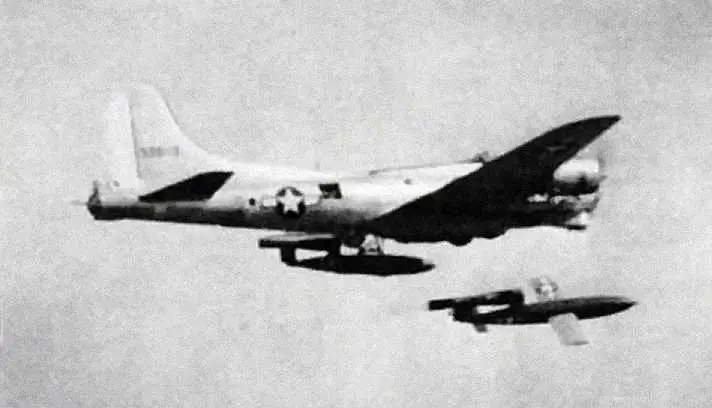
During testing, the JB-2 cruise missile confirmed its designed range and flight speed. However, the American military was categorically not satisfied with the accuracy of the shooting. In order to significantly reduce the probable circular deviation from the aiming point, it was decided to use radio command guidance with tracking using the SCR-584 radar and the AN/APW-1 radar guidance system.
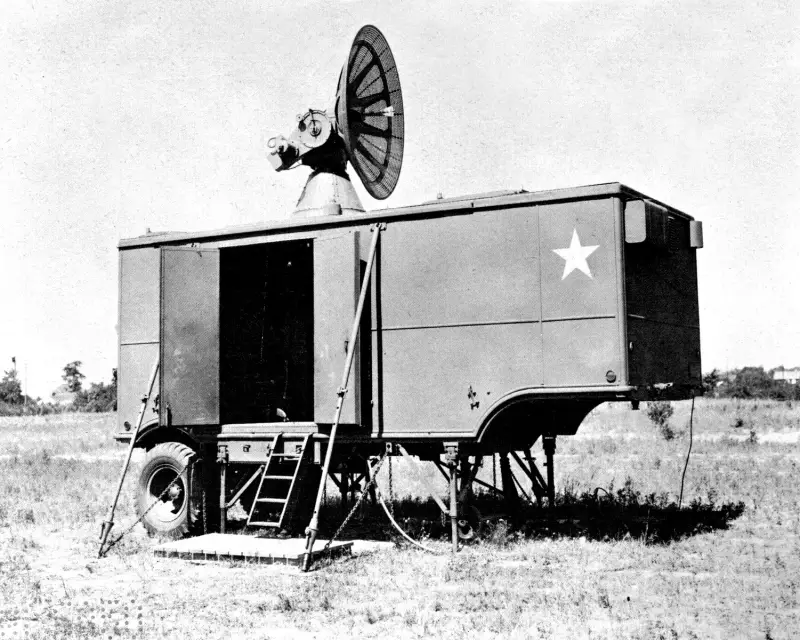
Radar scr-xnumx
To facilitate missile tracking, there was a radio transmitter on board. Radar equipment for tracking and targeting could be located in a towed van, on a ship or on board an aircraft. After fine-tuning this system, when firing at a distance of 160 km, the probable circular deviation was 400 m, which made it possible to effectively strike railway stations, ports, large factories and warehouses.
In parallel with the testing of the radar guidance system, in the spring of 1945, the formation of missile squadrons began, which were planned to be used against Japan. As part of Operation Downfall, before the landing of American assault forces on the Japanese Islands, it was planned to conduct massive bombing and shelling of Japanese territory for 180 days, actively using “rocket bombs” in this. According to American plans, the total production of JB-2 was supposed to be 75 units, with a launch rate of 000 units per day from carrier aircraft and ships. Approximately 100 cruise missiles were supposed to be fired at Japanese targets immediately before the landings.
Japan surrendered much earlier than American military analysts predicted, and production of the JB-2 ceased on September 15, 1945. A total of 1391 copies were made.
After the end of World War II, “Lun” for some time was the only combat-ready guided missile in the US armed forces. In this regard, the JB-2 was actively tested, participated in various exercises and experiments, and also served as a flying laboratory for testing new guidance systems.
Air-launched missiles served as aerial targets for anti-aircraft and fighter training in the late 1940s. The first thermal homing heads were also tested on them.
After 1947, cruise missile launches continued from Holloman Air Force Base in New Mexico, using the White Sands Missile Test Range. Test launches here continued until the second half of 1949.
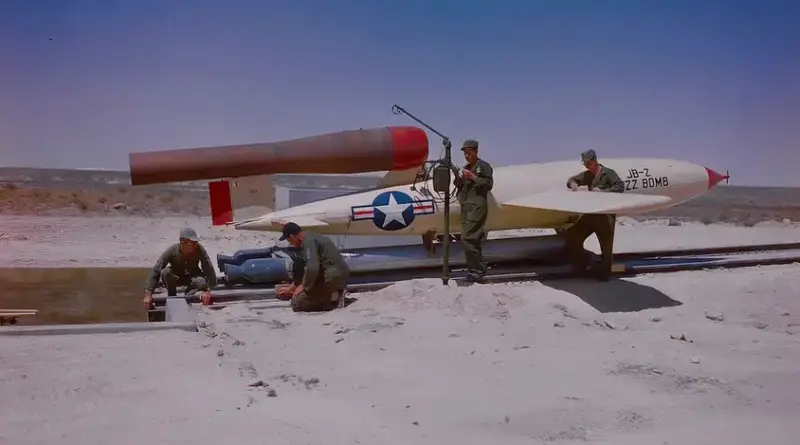
Preparing the JB-2 cruise missile for test launch at Holloman AFB, May 1948
In the first post-war years, the JB-2 was planned to be used as a means of delivering a nuclear charge. However, due to the not very high technical reliability of the cruise missile, rapid physical and moral obsolescence, it was used only to test the control equipment and launch device used on the serial MGM-1 Matador cruise missile, equipped with a 50 kt nuclear warhead, which had, depending on modifications flight range from 400 to 950 km.
American admirals also became interested in the new missile weapons, and experimental launches of Lun missiles continued at Point Mugu airbase. Initially, they planned to arm cruisers and light aircraft carriers with cruise missiles. But subsequently the command of the US Navy decided that submarines were more promising carriers.
For this purpose, the rocket was modified, and on the submarine it was placed in a special waterproof container. The launch was carried out from the surface position, from a ramp installed in the stern.
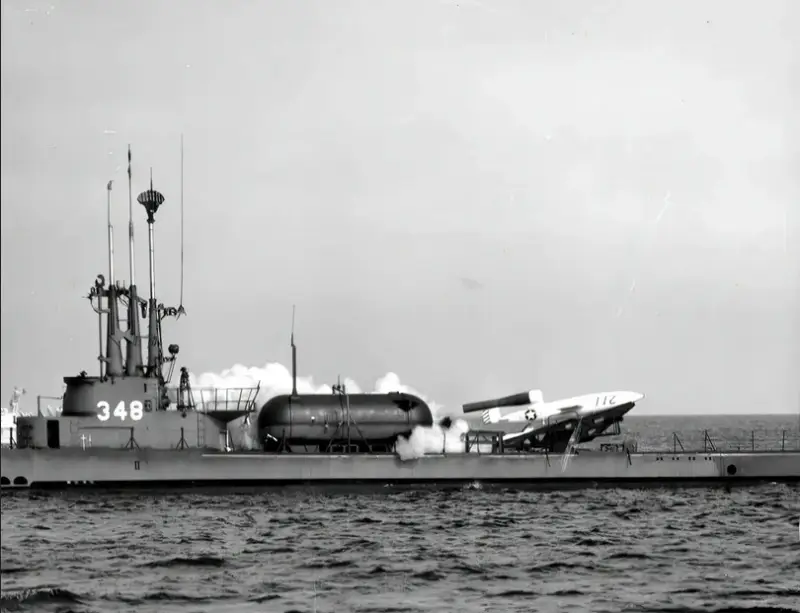
Launch of a JB-2 cruise missile from the submarine USS Cusk SSG-348 in 1951
The missile was guided from the submarine USS Carbonero (SS-337), on which, in addition to radar equipment and a command transmitter, it was also planned to install a container and a missile launcher.
The fleet continued launching the JB-2 until September 1953. At the same time, control equipment, a new propulsion system and guidance techniques for remotely controlled vehicles were tested. The resulting developments were subsequently used on the SSM-N-8 Regulus naval cruise missile, which was equipped with nuclear warheads and could strike at ranges of up to 920 km.
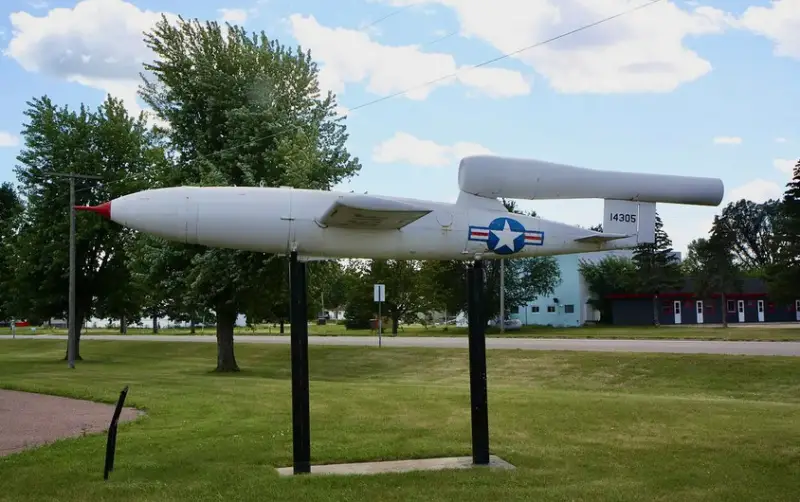
Currently, several JB-2 cruise missiles are displayed in museums and erected as monuments.
In the Soviet Union, on the basis of Fi 103, the design bureau of plant No. 51 (future OKB-52) under the leadership of V. N. Chelomey created the 10X projectile aircraft. Pe-8 and Er-2 bombers were considered as its carriers.
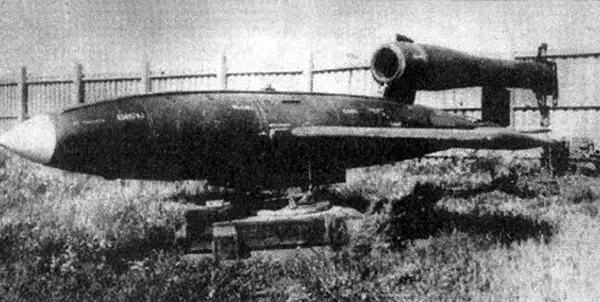
10X Projectile
In its main characteristics, the 10X rocket differed little from the German prototype. With a launch weight of 2130 kg, the aircraft, equipped with an 800 kg warhead, had a maximum flight range of 240 km. Speed: 600-620 km/h.
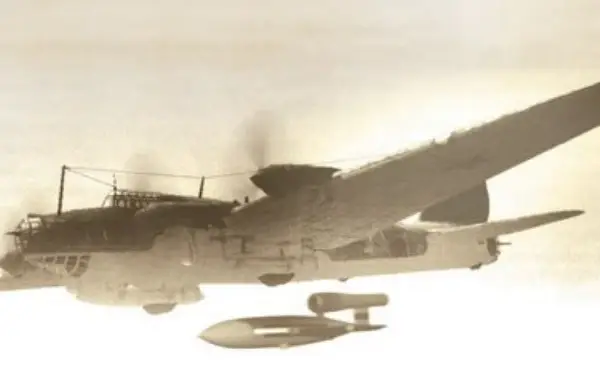
Launch of 10X from a Pe-8 bomber
The first flight test of the 10X took place on March 20, 1945 at a test site near the city of Jizzakh in Uzbekistan.
In 1948, after comprehensive tests, the projectile was recommended for adoption by the Air Force. However, the military was not satisfied with the low accuracy of the inertial guidance system, and they refused to accept this missile for service. Air Force officials also pointed out that the 10X's low speed and altitude make it an easy target for fighter jets.
In 1951-1952 a ground-based launch complex with a 10ХН rocket was tested, which was equipped with a solid-fuel launch device and had a new guidance system, the creators of which promised to increase hit accuracy.
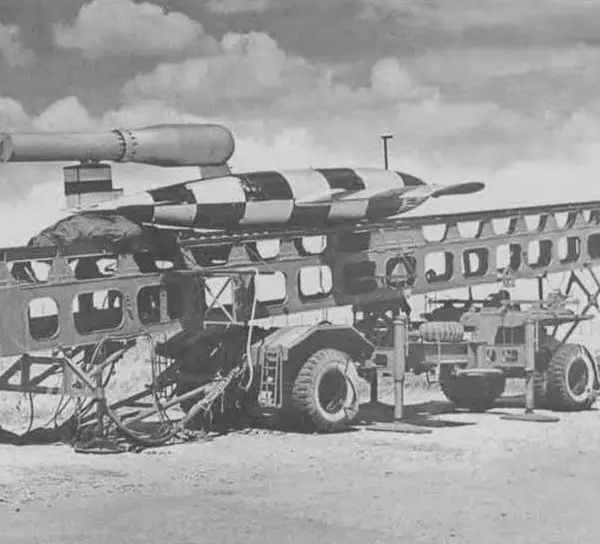
Launcher with ground-based cruise missile 10ХН
Without waiting for the end of the tests, the Smolensk Aviation Plant received the task of producing 50 10ХН cruise missiles, which were considered as training missiles and were to be used to train rocket scientists until more advanced models appeared.
To confirm the stated characteristics, in October 1956 it was decided to shoot six serial 10ХН. Due to errors in pre-launch preparation, the first launch was an emergency. In the summer of 1957, after modifications were made, control launches of five more 10XNs were carried out, of which four reached the specified area. At the same time, the average flight speed turned out to be 10-40 km/h lower than declared.
According to the commission, consisting of representatives of the Ministry of Defense and the State Committee on Aviation Technology, the 10ХН aircraft projectile did not meet the requirements for modern weapons and did not provide reliable operation over the entire temperature range. They decided to use serially built projectile aircraft as training targets in the air defense and air force systems.
A further development of the 10X family was the twin-engine projectile 16X. Its appearance is due to the fact that, according to calculations, the use of two pulsating air-breathing engines theoretically made it possible to approach a speed of 900 km/h.
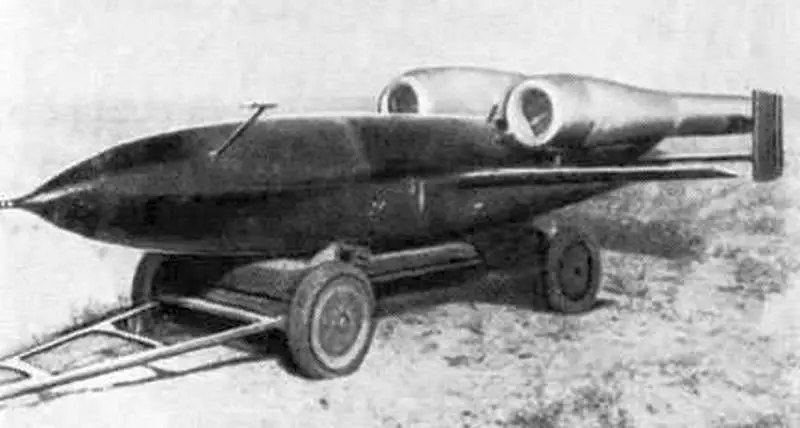
16X Projectile
Since the military refused to adopt a cruise missile that had low hit accuracy, the modification 16ХА "Priboi" provided for the use of tele-guidance, in which at the final stage of the flight the on-board television camera was turned on and the image was broadcast via radio channel to the carrier aircraft, the operator found on his sight target and used radio commands to correct the missile’s flight.
The modernized 16ХА "Priboi" with two D-14-4 engines with a total thrust of 500 kgf had a starting weight of 2557 kg and carried a high-explosive warhead weighing 950 kg. Speed – about 650 km/h. Range – 190 km. Launch altitude – 5000 m. Flight altitude in the main section – 800-1000 m.
Due to the lengthy development of the television guidance system, the first launch of a rocket with it took place on August 2, 1952. During testing, tele-guidance did not work reliably. Despite this, on October 15, 1952, the 16ХА was recommended for adoption. Having familiarized himself with the test materials, the Commander-in-Chief of Long-Range Aviation refused to accept the 16XA, citing the inadequacy of the television guidance equipment and the low flight speed. Due to the emergence of rockets with other types of engines that provided better speed and altitude characteristics, development of the 16XA was considered inappropriate and the topic was closed in February 1953.
A French drone based on the Fi 103 is known as the ARSAERO CT 10. This aircraft, designed by Arsenal de l'Aéronautique, had radio remote control. Thanks to the parachute landing method, it was possible to reuse it. The CT 10 was launched from a ground installation using powder accelerators.
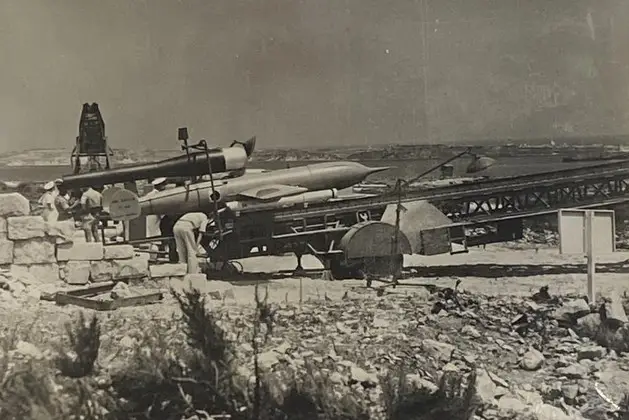
Since the French ST 10 did not carry a warhead, it was much lighter and more compact. Its length was a little over 6 m, its wingspan was 4,3 m, and its launch weight was 670 kg. Maximum speed – 460 km/h. Flight range – 320 km. Maximum flight altitude is 4000 m.
Testing of the ST 10 began in 1949, and the UAV has been mass-produced by Nord Aviation since 1952. In total, more than 400 copies were built, which, in addition to the French Air Force, were used as aerial targets in Great Britain, Italy and Sweden until the second half of the 1960s.
In Sweden, after studying the wreckage of Fi 103 found in the country in 1944, they also decided to create their own “flying bomb”. In 1946, Saab AB began development of the Robot 310 (also known as Lufttorped 7) cruise missile.

Cruise missile Robot 310
The Robot 310 cruise missile was intended to be launched from combat aircraft at enemy targets from beyond the effective range of anti-aircraft artillery.
The Swedish rocket had a significantly redesigned layout compared to the Fi 103. The designers of Saab AB placed the PURD along the axis of the body, moving the air intake slots to the sides in the middle part of the fuselage. Due to this, they managed to significantly reduce the dimensions of the rocket.
The length of the hull, including the engine, was 4,73 m, the span of straight wings was 2,5 m. Weight was 265 kg (possibly without a warhead). Flight speed is about 670 km/h, with a firing range of 17 km.
About 1949 missiles were fired for testing in 200. But based on the results of military tests, the Robot 310 series was not launched. The characteristics of the missile were already clearly insufficient to guarantee the destruction of the target or at least the invulnerability of the carrier aircraft in the conditions of the use of jet interceptors and radar-guided anti-aircraft guns equipped with shells with radio fuses.
Продолжение следует ...
Information